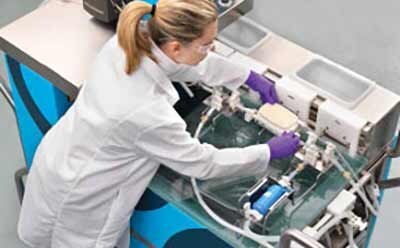Detecting Viral Contamination in mAb Process

In today’s biomanufacturing environment, confirming that process intermediates are free from detectable adventitious virus presents challenges. Traditional in vitro and in vivo virus testing typically take several weeks to complete and frequently offer limited sensitivity and identification of specific contaminants. Additionally, regulatory and ethical imperatives to decrease the use of animal models has reinforced demand for a new approach to biosafety testing. Molecular testing technologies have been developed, offering speed to results with the sensitivity and specificity to meet the needs of today’s biomanufacturers.
The evolution of biomanufacturing towards process intensification and continuous manufacturing, coupled with the more diverse range of patient treatments being developed, are powerful drivers for this new approach to accelerated biosafety testing.
Related Technical Articles
- Viral safety in bioprocessing relies on a framework of (1) preventing contamination, (2) detecting contamination, and (3) removing or inactivating viral contaminants.
- A 2021 survey shows recent trends in outsourcing the development and manufacturing of biologics like monoclonal antibodies.
- Continued process verification is critical to maintain the strength, quality, and purity of the final drug product. It is a regulatory expectation as manufacturers are instructed to ensure their process remains in a continual state of control. Learn more in this technical article.
- This application note describes the benefits and performance of Cellvento® 4CHO-X Expansion Medium designed for multiple cell expansion steps from vial thaw to N-1 stages to generate higher biomass for inoculating fed-batch production bioreactors
- The accelerated mAb development program delivers GMP drug substance nine months from transfection. We designed the mAbExpress™ program to be fast, cost effective, and appropriate for the early clinical phase of your program, with regulatory support throughout.
- The performance of membrane adsorbers for antibody purification is compared to quaternary amine resins, membranes, and salt-tolerant primary amine membranes.
- Demonstration of the excellent capability of Carboxen® synthetic carbon adsorbents to reduce host cell proteins (HCPs) and recover monoclonal antibodies (mAbs) using a post protein A pool step.
- See All (7)
Rapid Detection Methods
Molecular testing technologies for detecting viral contamination can often deliver results in a few days or a week, compared to up to and often beyond 35 days for more traditional bulk harvest lot release testing methods. Directed polymerase chain reaction (PCR) and next generation sequencing (NGS) technologies each have advantages: PCR offers speed and sensitivity, while NGS features a broad detection range. A new rapid molecular detection platform utilizing a highly multiplexed degenerate PCR approach combines the benefits of both traditional PCR and NGS: rapid results with coverage of more than 5,000 viral variants, expediting biomanufacturing timelines for enhanced productivity.
Cell Line Characterization
Regulatory bodies currently require extensive cell line characterization to confirm species origin and history, as well as identity, stability, and purity. Today there are many options for this level of cell line analysis, with newer molecular methodologies offering more rapid time to results, allowing developers to get to clinic faster.
Raw Material Testing
Raw materials are a source of variability in biomanufacturing. Supplier transparency, coupled with comprehensive testing to fully characterize raw materials, as well as easy-to-access documentation, provide assurance that raw materials are fit for purpose.
Detection of Emerging Viruses
Viral contamination is a constant challenge to all biopharmaceutical production processes, with emerging viruses a particular concern. Understanding the susceptibility of raw materials to these viral contaminants, and the capability of both classical and molecular testing methods to detect them, is an essential part of any viral safety strategy.
Related Webinars
Learn about existing and emerging methods to accelerate biosafety testing of biologic therapies.
Replacing the MAP/HAP test is a first step to reducing the overall timeline for CHO cell line characterization from months to mere weeks.
Learn about CMC testing requirements with CHO production platform for global commercialization, lot release testing of product intermediates and final product, product-specific qualification study, and alternative rapid testing methods to advance lot release testing.
Emerging viruses represent a constant challenge to biopharmaceutical manufacturers, and therefore formal risk assessments and informed programs of safety testing are necessary to assure safety.
Workflow


Removing Viruses Downstream
Implementation of technologies to remove or inactivate viruses and execute clearance studies that demonstrate process safety.

Monoclonal Antibody Manufacturing
Monoclonal antibody (mAb) therapeutics are manufactured using a templated approach that requires robust, scalable solutions for all steps from cell line development to final fill.
Related Resources
- Viral Safety in Bioprocessing
Viral safety in bioprocessing relies on a framework of (1) preventing contamination, (2) detecting contamination, and (3) removing or inactivating viral contaminants.
- White paper: Rapid Biosafety testing enables the future of manufacturing
The safety of biologic medicines relies, in part, on a robust biosafety testing program applied across the biomanufacturing process to evaluate samples for the presence of adventitious agents.
- White Paper: Alternatives to In Vivo Assays for Biosafety Testing of Biologics Medicine Maker Article: A Biosafety Revolution
The use of animal models for the detection of adventitious agents has been a feature of biologic testing packages for many decades. However, as alternative methods such as PCR and NGS have emerged these in vivo tests have stubbornly remained a central part of testing. Here we examine the current in vivo methods and explore alternatives which can be employed today. We also propose that while the industry may be some years away from removing in vivo testing completely, a case can be made for removing animal use from well-characterized production systems such as CHO.
- White Paper: Avoid Surprises With Comprehensive Cell Line Characterization
A robust strategy for viral safety assurance is an essential component of every biopharmaceutical manufacturing process and typically consists of three pillars: prevent, detect, and remove.
- eBook: Viral Safety: a Global Regulatory Perspective
Guidance for Raw Materials and Cell Lines, Preventing Contamination, Detecting Contamination, Viral Clearance Evaluation
To continue reading please sign in or create an account.
Don't Have An Account?